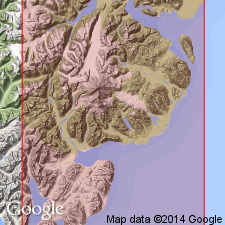
- Usage in publication:
-
- Horn Mountain Tuff Member*
- Modifications:
-
- Named
- Dominant lithology:
-
- Tuff
- Sandstone
- AAPG geologic province:
-
- Alaska Southwestern region
Summary:
Pg. 18-20, 23 (fig. 2), pls. Horn Mountain Tuff Member, upper member (of 3) of Talkeetna Formation. Exposed in narrow belt 0.75 to 1.0 mile wide along west side of Portage Creek Valley. Bedded tuffs and tuffaceous feldspathic sandstone are dominant lithologic types. Porphyritic andesite lava flows are present locally. Minor constituents are volcanic breccia, agglomerate, greenstone, and argillite. Thickness 1,800 feet at type locality. Thickest measured section, on south shore of Tuxedni Bay, is 2,850 feet. Overlies Portage Creek Agglomerate Member (new) of Talkeetna Formation. [In places] is in fault contact with Portage Creek. Underlies Red Glacier Formation of Tuxedni Group. Top of all sections is either an angular unconformity or a fault. Age is Early Jurassic based on correlation with beds in upper part of Talkeetna Formation in Talkeetna Mountains area.
Type section: Horn Mountain, from the shore of Chinitna Bay to the peak of Horn Mountain and north along the ridge to the contact with Portage Creek Agglomerate Member, Iniskin-Tuxedni region, southwestern AK. Named from Horn Mountain, south shore of Tuxedni Bay.
Source: US geologic names lexicon (USGS Bull. 1350, p. 343); supplemental information from GNU records (USGS DDS-6; Menlo GNULEX).
For more information, please contact Nancy Stamm, Geologic Names Committee Secretary.
Asterisk (*) indicates published by U.S. Geological Survey authors.
"No current usage" (†) implies that a name has been abandoned or has fallen into disuse. Former usage and, if known, replacement name given in parentheses ( ).
Slash (/) indicates name conflicts with nomenclatural guidelines (CSN, 1933; ACSN, 1961, 1970; NACSN, 1983, 2005, 2021). May be explained within brackets ([ ]).

